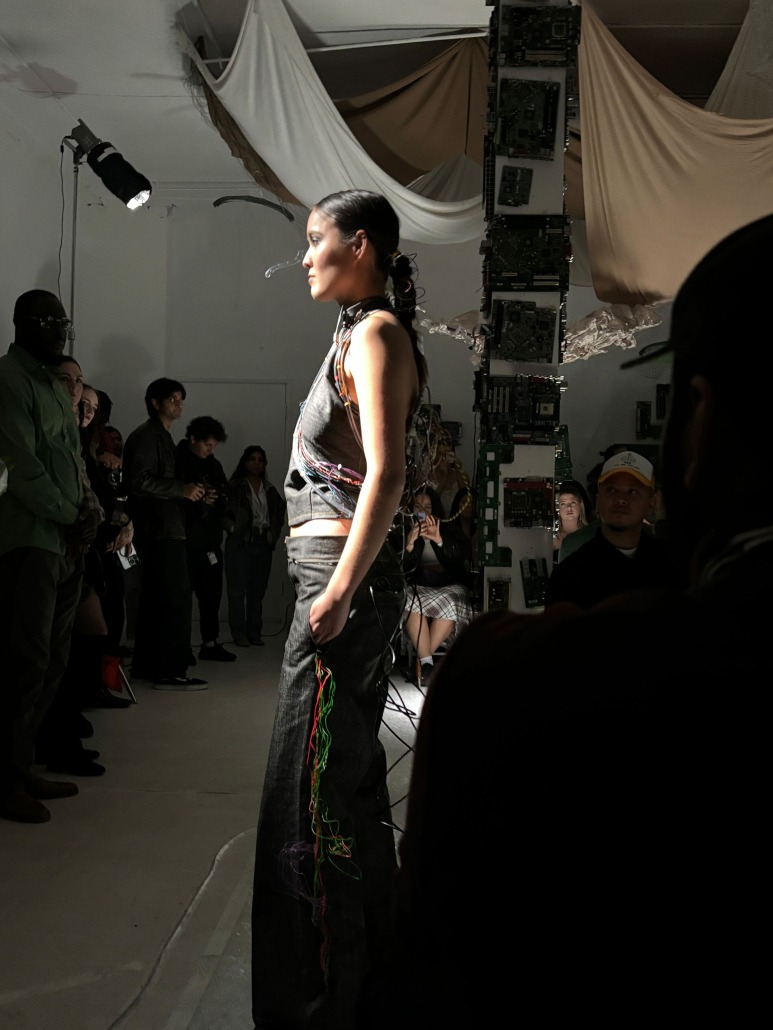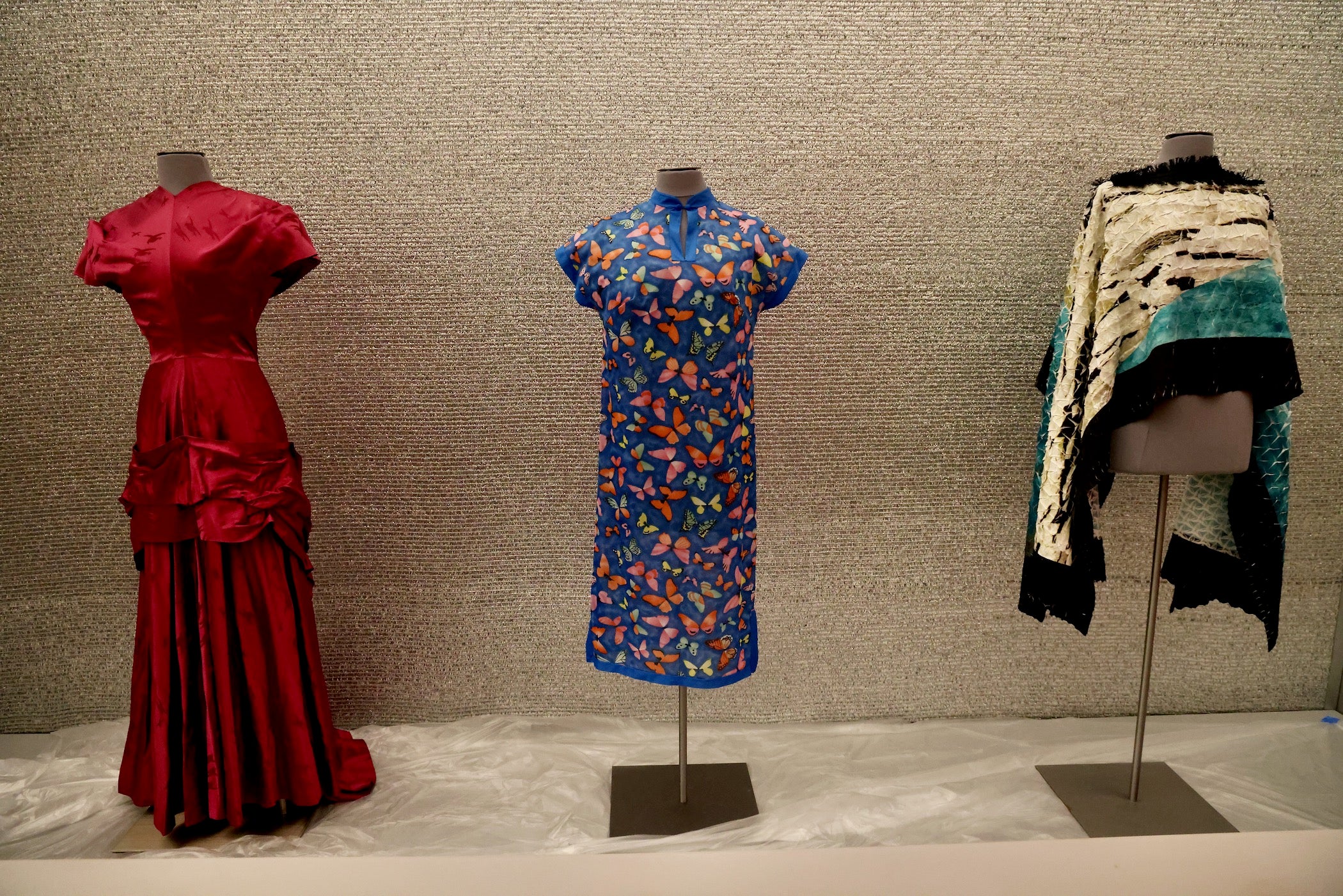Fashion
Fast fashion’s dark side brought to light – Daily Trojan

On Saturday night, USC students and friends gathered at a small downtown warehouse for a mysterious new fashion show, It Dies and So Lives. Upon entering, attendees were given the show’s program in the form of a bundle of receipts filled with credits and resources to learn about sustainable fashion.
Excitement permeated the atmosphere as the audience filled out into seated and standing sections, investigating the receipts and taking in the bubbly yet ominous energy. Decorating the walls was a swath of green computer motherboards and wires, and floating above it all was an installation of chicken wire, fabric, crumpled paper, and clothing hangers suspended from the ceiling.
Daily headlines, sent straight to your inbox.
Subscribe to our newsletter to keep up with the latest at and around USC.
The show began abruptly with the clack of a typewriter setting off a slew of ambiguous, industrial black and white visuals on two large screens that also served as an entrance and exit for the models.
Projection artist Xinghan Zhuang, a senior majoring in media arts and practice as well as architectural studies, used AI to create visuals that juxtaposed the environmental damage created by technology and the fashion industry.
“We’re actually shooting the audience footage, and then kind of project[ing] onto the wall live. And then we are transforming the audience into the AI rubbish,” Zhuang said. “We’re kind of giving them the warning, you guys can produce garbage, so please don’t do so.”
Mesmerized first by an abstracted clip of newspapers rolling down a conveyor belt, the audience was transported to the next phase of the show. Leading up the models’ entrance, the music shifted suddenly, transforming into a stimulating beat.
Sound designer Kainoa Rojas, a junior majoring in nursing at California State University, Long Beach, had a strong guiding vision.
“I gathered a lot of heavy bass synthesizers and a lot of sine waves to make the audience feel like they’re on the edge of their seat. And on top of that, I sampled a lot of construction sounds and sewing machines to kind of get with the whole electronic, ambient, eerie vibe,” Rojas said.
The first model entered, clad in piles of chains and straps, with holes in the jeans and a fur tail dangling from the waistband. The next model sported a corset made of tin foil, plastic wrap, and epoxy resin on top of a skirt that was cut to create a futuristic silhouette. Another model flaunted a shimmer golden tulle veil and voluminous dress with plaster robotic arms.
The next look featured a short ball gown made of bubble wrap accessorized with cage crinoline peeking out from underneath and a small piece of lace suggestive of a veil on her head. There was a macrame dress, hordes of layered and cut out fabric, chains, computer wires, and even a real computer motherboard incorporated into the looks. Each model looped around the audience, strutting down the bubble wrap runway.
Once the first model reappeared, the narrative began to shift. The ambiance changed as the music sped up and the bubble wrap catwalk popped at an exponentially louder volume. The body language of the models suggested a feeling of panic as they stumbled around the room at inconsistent speeds, looking around as if they had lost something. Consistent with the jarring panic of the moment, the models’ outfits featured new layers of plastic and trash.
Alani Marie Smith, a senior majoring in film and television production who modeled in the show, explained the vision behind this creative choice.
“The point was to have us in garbage, which is what fast fashion is nowadays, or what all of fast fashion is,” Smith said.
In the chaos, it was hardly noticeable that one of the screens that had been playing distorted visuals of smoke and nature had fallen down. The third musical shift occurred, playing faster than ever, and strobe lights set in. The models became dancers, interacting together for the first time as they slowly melded into the set.
The group became entangled with the screen, now more recognizable as a large blanket of tulle. They moved and breathed as one beneath the fabric, as flickering green light was projected onto them and sounds of chirping took over the space, signaling a regeneration of nature against the odds of technology. Finally, the room was dark and silent until applause spread across the audience.
The student-run event brought out fashion fans and friends of the designers and models there to cheer them on. Lyn Flake, a sophomore majoring in communication who came to support their friends, noted how unique the event was.
“I just wanted to support them and see different opportunities for models and the fashion space at our school, because I feel like USC doesn’t strike me as a fashion school,” Flake said. “So whenever there’s something in that space, I get really interested in it.”
Chloe Rankin, a junior studying film and television production, showed up to support her friend but also expressed interest in learning more about sustainable fashion.
“I feel like [sustainable fashion] is not mainstream. It’s kind of one of those concepts that people are like, ‘Yeah, we should do that,’ and then no one really does anything,” Rankin said. “This, being a display of art, is super engaging for people to get introduced to that topic.”
The show got people talking about sustainability but also inspired on a deeper level. Wilha Duncan, a junior studying fine arts, found it to be a cathartic experience.
“What made me cry is that some of my friends were modeling in it, and it was so beautiful to see people have their ideas come to fruition. And that was incredible,” Duncan said. “But then, on the other hand, it made me really feel emotional for our generation, and I feel like we really are all struggling, and getting damaged by technology.”
Ultimately, It Dies and So Lives used multimedia to highlight how the impact of fast fashion and climate change is felt across Gen Z, the hard work required to spread the word and inspire one another, and the urgent need to do so. Through an interdisciplinary web of art, the show asked the audience to consider their impact on the planet and personal relationship to fast fashion, while emphasizing the community needed to make a difference.
“Standing back and looking at the world around you and seeing that small artists and the younger generation are making our voices heard, I think the audience should take away that our generation has a lot to say,” Smith said.



/cdn.vox-cdn.com/uploads/chorus_asset/file/25739166/AAAAQT3Ud9lF0x4ARNE6dgM2F39BRnrQYAVXYXRmFPQwRqYE3WTXlgu9dQfP_1zYemEDv16jkFkA2cm9leR4Gbdwg9XmjMgmKKG1L7QekXO2UAqMELfi9umOvcxVSKNfgrYoYUc6HJPhyyaVb7F_YBXid9dGrBs.jpg)






